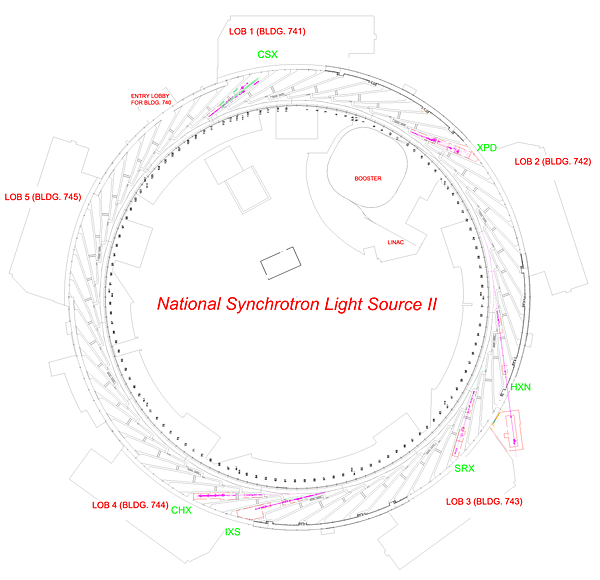Site Navigation
General Information
The Hutches Are Coming
Spring brings anticipation about the arrival of hutches for the initial set of six beamlines at the National Synchrotron Light Source II (see drawing). The new facility is now under construction at Brookhaven Lab.

Six beamlines and their hutches have defined locations on the NSLS-II experimental floor. Acronyms for the beamlines – CSX, XPD, HXN, SRX, IXS and CHX – are colored green. The hutches are outlined in red around the beamline components in magenta. HXN has a satellite hutch exterior to the ring building. The drawing is oriented with north at the top, and the lobby is the rectangle jutting beyond the outer perimeter of the ring to the left of LOB1 (first lab-office building). Drawing by Brian Mullany and Kelly Roy, both senior designers in the Accelerator Division.
As announced in September 2011, Global Partners in Shielding (GPS) is building 17 complete hutches. NSLS-II will produce extremely intense x-rays, used by scientific instruments to do experiments. To shield people from exposure to x-rays, the instruments must be contained in special enclosures, called hutches.
Installation of the first hutch, for beamline CSX, is expected to start in March. Hutch installation for beamline HXN will begin weeks later, with work for beamline XPD soon after. All seventeen hutches for the first six beamlines are presently scheduled to be installed by the end of calendar year 2012. When fully operational, NSLS-II will have up to sixty main beamlines, many of which will also have branch beamlines. Each main and branch beamline is built for a specific type of scientific research.
GPS, located in Passaic, New Jersey, is building two types of hutches: steel-encapsulated lead enclosures and all-steel enclosures. As explained by Photon Sciences project engineer Ed Haas, who is the technical point of contact for GPS, lead is a better shield than steel for hard x-rays but the lead must be encapsulated by sheet metal to prevent personnel from contacting the lead. The steel also gives the hutches greater load-carrying capacity. The lead/steel hutches will be used in specific locations around the ring where more shielding is required.
Haas has been to GPS several times to check on their progress. He and quality assurance engineer Joe Zipper also visited Mayco Industries in Birmingham, Alabama, and Brakewell Steel Fabricators in Chester, New York. These companies are two major subcontractors that are making lead and steel details (respectively) from GPS’ drawings.
“I’m impressed with the efforts put forth thus far by GPS,” said Haas. “They’ve hired several people, leased additional facility space, created a painting facility with a monorail system, and built specialized shipping and handling carts. Overall, GPS has been working diligently to accomplish the fabrication and installation work on schedule and according to our needs.”






